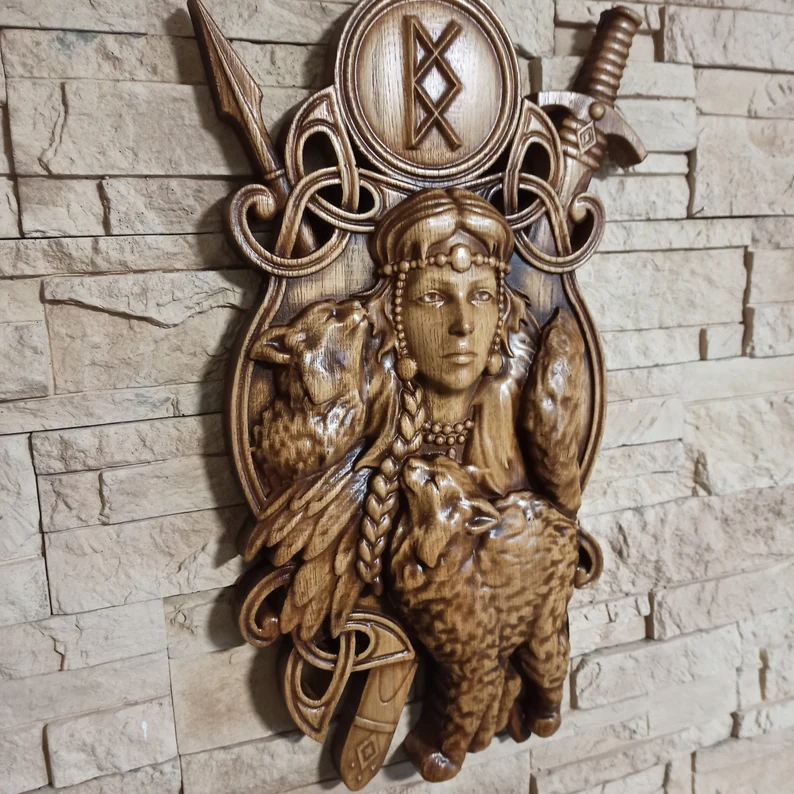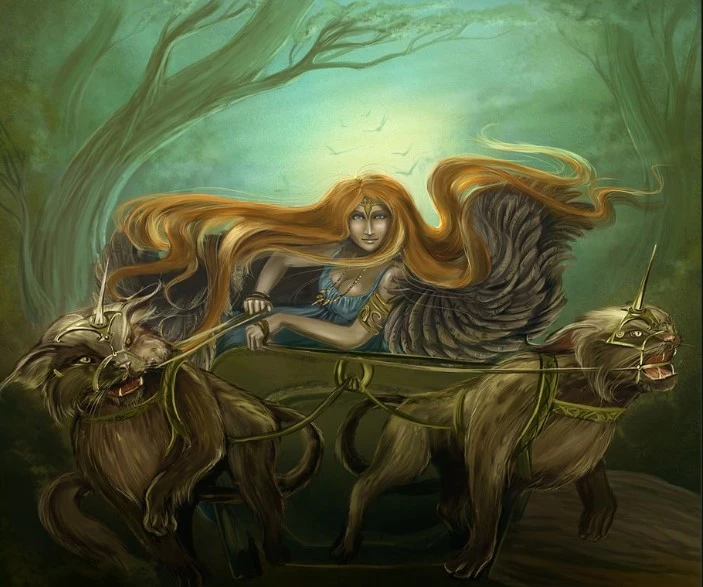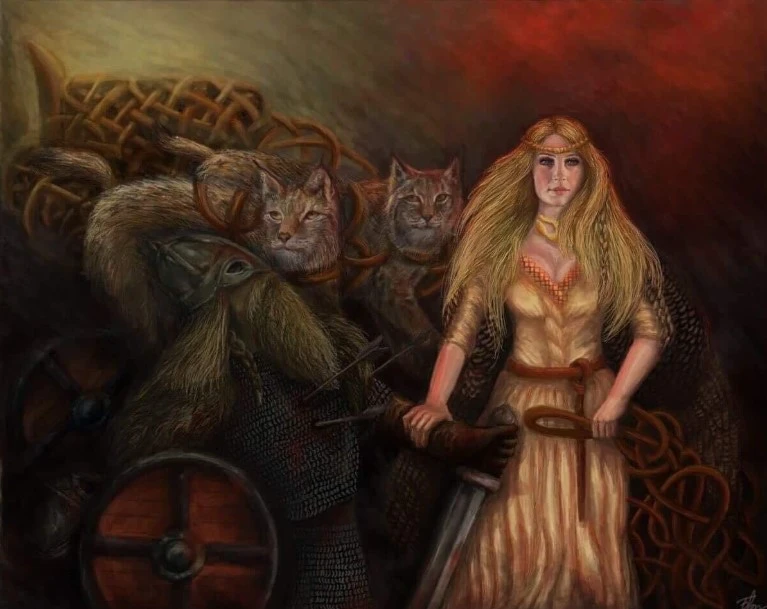Freyja isn’t actually a conventional name; in Old Norse, it translates to “lady.” The contemporary spelling of her name is “Freja,” which was later anglicized to “Freya.” She had a brother known as Freyr, which meant “Lord.” Both of them were born to Njoror, representing the sea, and Herta, symbolizing the earth. Freyja goddess symbols are just as powerful as the goddess herself.
Although she went searching for pleasure and passion, she was a complicated character. The Vikings saw her as a mighty force, a goddess on the same level as Odin and Thor in Norse mythology.


What is Freya the god of?
Although Freya was known as the goddess of love, she was also the fertility goddess and goddess of war and death. Old Norse literature highlighted her insistence on everything sexual. However, she has been completely omitted from childbirth, which is an element of fertility within the confines of other goddesses of similar nature.
According to Norse myth And Freya goddess Symbols, Freya was the Norse goddess of love, fertility, sex, war, death, magic, beauty, and witchcraft. She supervises battles, can grant and remove fertility, can be beseeched for love, and was born knowing the sacred secrets of witchcraft and the Runes. Because she belonged to the Norse Vanir tribe, people thought she practiced witchcraft and was strongly connected to the earth.
She considered pigs sacred and rode a boar with golden bristles. She also had a chariot drawn by cats as another means of transport. Freya was privileged to have the opportunity to choose half of the warriors slain in battle for her great hall in Folkyangar, while the rest were taken to Valhalla by the god Odin.
She had a famous necklace known as Brisingamen that was stolen by the god Loki, the trickster, and later recovered by Heimdall, a watchman to the gods.
Freya is believed to have done the evil act of teaching the Aesir, a tribe of gods, witchcraft.
Like the Egyptian goddess Isis and Greek goddess Aphrodite, Freya traveled the world looking for a missing husband while shading golden tears. She had four nicknames: Horn, Mardoll, Syr, and Gefn.
Freya’s themes included strength, devotion, the sun, passion, and magic. Her symbols consist of lions and strawberries.
Freya was not a mysterious goddess; on the contrary, she was loved and worshipped all over European territory in places such as Iceland, Greenland, Scandinavia, the Germanic lands, Anglo-Saxon Britain, and Holland. She remains among the most loved and idolized Pagan goddesses to date.
The spirit of Freya angered Christian authorities. Ironically, this anger propelled Freya to survive more vividly than any other European female spirit. Continuous condemnation ensured Freya remained relevant.
Freya was criticized as the Queen of Witches. Women who idolized her were automatically labeled as “witches’. Freya’s rites and traditions encouraged magical practice, shamanism, mediumship, and female autonomy, while Freya acted as a role model. The new regime viewed this behavior as an abomination and symbolizing deadly sin.
The Vanir
The Norse gods are divided into two: the Vanir and the Aesir. Freya and her family belong to the Vanir, and unlike their counterparts, little is known about the rest of Freya’s family.
All that is known is that there was a war between the Aesir and the Vanir, with the Aesir emerging victorious. Freya and her brother Freyr were sent to live with the Aesir as part of the truce agreement.
According to Norse mythology, the Vanir lived in what is presently referred to as Scandinavia when the Aesir arrived. The Vanir provoked greater hostility from the Christian church than the Aesir; therefore, limited information concerning the Vanir survived.
The only information available about the Vanir was retrieved from those sent to live in Aesir.It is believed that the Vanir were shapeshifters linked to creative energy, magic, the sea, eroticism, fertility, prophecy, and shamanism.
According to the myth, Freya shared all her knowledge with the Aesir after being taken hostage. The Norse god Odin was the first member of the Aesir to befriend Freya. By becoming close to Freya, the god Odin learned about the ways of Seidr magic. Seidr was a form of magic perceived as a woman’s magic and unsuitable for men.
Freya knew all about the Runes, but according to the myth, her knowledge of the Runes directed Odin to gorge out one of his eyes and hang himself from Yggdrasil upside down while looking into the Well of Wyrd. After staring into the well for nine days and nights, he finally understood what the Runes meant.
Freya and Warfare
Freya, the queen of love and war who goes by the name Valfreya, leads the Valkyries into battle. The Valkyries are angels of death who transport the souls of the recently departed to the next realm, and in battle, the souls are transported to two different destinations.
The Valfreya get the first picks of the departed souls, followed by Odin, but finally, all the souls of the dead are evenly split. The souls chosen by Odin are taken back to Valhalla, whereas those chosen by Freya are taken to her realm, which goes by the name of Folkvangr, a meadow with a large hall known as Sessrumnir. In Folkvangr, love songs are always played.
Freya and Frigg
There are similarities between Freya and Odin’s wife, the Norse goddess Frigg. Some people have reasons to believe that Freya and Frigg are one person. This argument is supported by the fact that Freya is technically not a name but a title, whereas Frigg is a name.
Frigg is also referred to as the “well-beloved lady.” She can also be called Frigga, Sacka, or Fricka. She is the goddess of childbirth, fertility, matrimony, and divination. It is unclear whether she is part of Aesir or Vanir.
Since she is the wife of Odin, she is linked to marriage and fidelity. In the afterlife, married people spend their time in Frigg’s hall, known as Fensalir. It is not easy to differentiate between Freya and Frigg.
They are two different spirits in Scandinavia but seem to have merged into one spirit in German land. The distinctions can still be made even if some information has been lost or suppressed.
Ironically, even though Christian authorities were against Freya, there is still substantial information about Freya and her beliefs.The theory that Freya and Friggs are the same people is exacerbated by the belief that Freya’s husband, Odr, is Odinn, and their two daughters go by the names Hnoss and Garsemi. Not much is said about the two daughters.


Freya Attributes and Association
According to Norse myth, the beautiful Norse goddess Freya has long blonde hair. We must know that she is a shapeshifter capable of assuming any form. She has a magical falcon cloak, which she uses to fly. She also wears a necklace mentioned earlier in this article that the Brisingamen dwarfs made.
Her chariot is pulled by two silver cats, which some people think are called Bygul and Trjegul. These cats might be lynxes. Freya is associated with different animals, such as cats, rabbits, falcons, cuckoos, ladybugs, swallows, boars, and oxen.
Her preferred colors are green, red, yellow, light blue, pink, and white. Freya’s materials of choice include gold and amber. She is also a fan of flowers. Plants associated with the queen include:
- Primrose
- Opium poppy
- Rose, clover
- English daisy
- Hemp, Arnica
- Almond, Bedstraw
- Bird Berry
- Benzoin
- Henbane
- Strawberry
Essential oils linked to her include sandalwood, Birch, Benzoin, Cypress, Myrrh, and Rose. You can include any of the mentioned items when offering to the goddess. You can also add her favorite foods: pork, honey, mead, ale, apples, edible flowers, and barley.
Because of her love for cats, you can pay homage to the goddess by treating cats well. The goddess of love is a fan of love poems and songs continuously playing in Folkvangr. The Freya goddess can be considered a source of inspiration among ancient and present cultures. The mythology also proves that the Nordic people had a rich culture that is present to date.


Pingback: Celtic Magic and Spells: A Deep Dive into Ancient Traditions -
Hello there! Do you know if they make any plugins to safeguard
against hackers? I’m kinda paranoid about losing everything
I’ve worked hard on. Any tips?